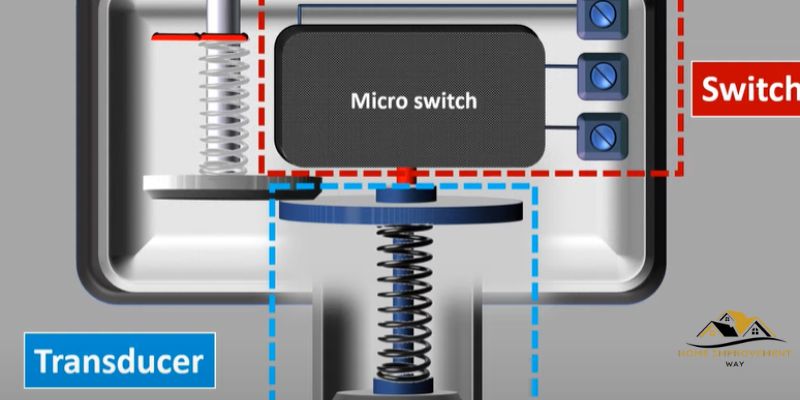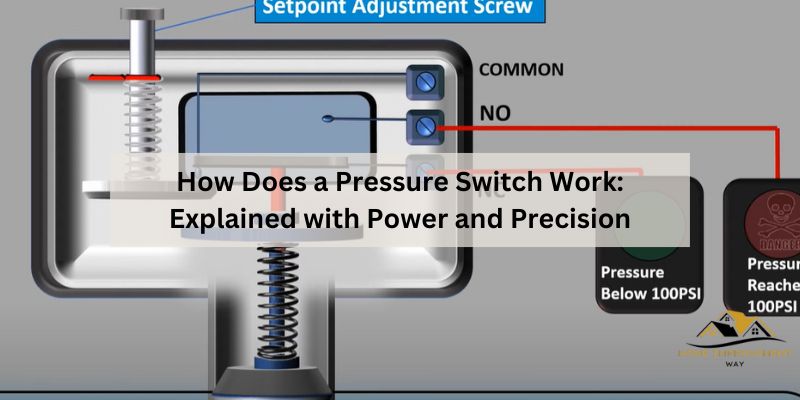A pressure switch works by detecting changes in pressure and activating or deactivating a circuit accordingly. A pressure switch is a device used to monitor the pressure in a system and trigger an action based on pre-set parameters.
It consists of a switch and a sensing element, which is usually a diaphragm or a piston. When the pressure reaches a certain level, it causes the sensing element to move, either opening or closing the switch. This action can be used to control various operations, such as starting or stopping a pump, activating an alarm, or shutting off a system to prevent damage.
Pressure switches are commonly used in applications like air compressors, hydraulic systems, and water pumps.
Components Of A Pressure Switch
Pressure Sensing Element
The pressure-sensing element is a crucial component of a pressure switch. It is responsible for detecting the changes in pressure and converting them into electrical signals. Generally, pressure switches employ various types of pressure-sensing elements, such as diaphragms, bellows, Bourdon tubes, or solid-state sensors. These elements possess unique properties that enable them to accurately measure pressure variations and initiate the switch’s response accordingly.
Electrical Contacts
Electrical contacts in a pressure switch play a vital role in controlling the electrical circuit that activates or deactivates a device. These contacts can either be normally open (NO) or normally closed (NC). In the NO configuration, the contacts remain open when the pressure is below the specified threshold, but close once the pressure surpasses it.
Conversely, in the NC setup, the contacts stay closed at low pressure and open when the pressure reaches or exceeds the designated level. These contacts allow the pressure switch to control the operation of various devices, such as pumps, motors, or alarms.
Adjustment Mechanism
The adjustment mechanism is an essential feature of a pressure switch, enabling users to set the desired pressure thresholds. It typically consists of a screw or knob that alters the tension on the pressure-sensing element, allowing for precise adjustments.
By turning the adjustment mechanism, users can control at what pressure the switch should activate or deactivate the connected device or system. This adjustability allows pressure switches to be versatile and adaptable to different applications, ensuring accurate and reliable performance in diverse pressure conditions.

How Does A Pressure Switch Work?
A pressure switch is a vital component of various systems and devices that rely on pressure control, such as air compressors, water pumps, or even dishwashers. This ingenious device automatically monitors and regulates pressure levels, ensuring proper functioning and preventing potential damage or failure.
Pressure Sensing Process
At the heart of a pressure switch lies its pressure-sensing mechanism, which plays a crucial role in its operation. The pressure sensing process involves the use of a diaphragm or a bourdon tube, configured to detect changes in pressure.
When pressure is applied to the sensing element, it causes a deformation that is then translated into a mechanical displacement. This displacement is measured and used to determine the pressure level.
In a nutshell, when the pressure exceeds a predetermined value, the sensing element is activated, triggering the pressure switch to perform its designated action.
Electrical Circuit Operation
While the pressure sensing process establishes the foundation for a pressure switch, its electrical circuit operation brings it to life. The switch consists of two electrical contacts – a normally open (NO) contact and a normally closed (NC) contact.
When the pressure is below the predetermined value, the NO contact remains closed, completing the circuit. This allows the current to flow and power the connected device or system, enabling its operation.
However, as the pressure increases and reaches or exceeds the set limit, the NO contact opens, thereby breaking the electrical circuit. Consequently, the flow of current is disrupted, preventing further operation or initiating a desired control action.
On the other hand, the NC contact works inversely. When the pressure is below the threshold, the NC contact remains open. But once the pressure surpasses the specified limit, the NC contact closes, completing the circuit and facilitating the necessary action.
This simple yet effective mechanism ensures that pressure-dependent systems operate within safe parameters, providing efficient control and protection against potential failures.
Applications Of Pressure Switches
Pressure switches are versatile devices widely used in various industries for different applications. They are designed to monitor and control pressure levels in a system, triggering specific actions whenever the pressure crosses a predetermined threshold. With their reliable and accurate functionality, pressure switches prove to be essential components in a range of applications. In this article, we will explore some of the major applications of pressure switches.
Industrial Automation
Pressure switches play a crucial role in industrial automation processes, helping maintain optimal operating conditions and ensuring efficient system performance. In manufacturing plants, pressure switches are used to monitor the pressure within hydraulic and pneumatic systems. By sensing pressure fluctuations, these switches can detect a fault or a drop in pressure, instantly signaling the control system to take appropriate measures. Whether it’s controlling the pressure within a hydraulic press or monitoring air compressor systems, pressure switches guarantee smooth and reliable operations.

Pump And Compressor Systems
Pressure switches find extensive applications in pump and compressor systems, where they provide critical feedback and protection mechanisms. These switches are employed to regulate system pressure and prevent any damage caused by overpressure or underpressure conditions.
In pump systems, pressure switches ensure the proper functioning of pumps by automatically turning them on or off based on the pressure set in the switch. Similarly, in compressors, pressure switches protect the unit from excessive pressure, avoiding potential equipment failures or accidents. Whether it’s maintaining pressure in a water supply system or ensuring efficient air compression, pressure switches are fundamental components in pump and compressor systems.
HVAC Systems
Pressure switches also play a key role in HVAC (Heating, Ventilation, and Air Conditioning) systems, contributing to the comfort and safety of commercial and residential spaces. These switches monitor pressure levels in refrigeration and air conditioning units, ensuring their efficient and reliable operation.
By controlling the compressor, pressure switches help achieve the desired temperature and ensure the system operates within safe pressure limits. In HVAC systems, pressure switches help prevent refrigerant leaks, optimize energy consumption, and protect the equipment from excessive pressure or low-pressure conditions.
Conclusion
Pressure switches play a crucial role in various industries by ensuring the smooth operation of equipment. Their working principle, relying on the pressure levels to control and monitor systems, allows for efficient and safe functioning. By providing accurate measurements and triggering necessary actions, pressure switches assist in maintaining optimal conditions.
Understanding how pressure switches work empowers individuals to troubleshoot and make informed decisions, contributing to enhanced productivity and cost-effectiveness. Stay updated with the latest advancements in pressure switch technology to adapt to evolving industry needs.


